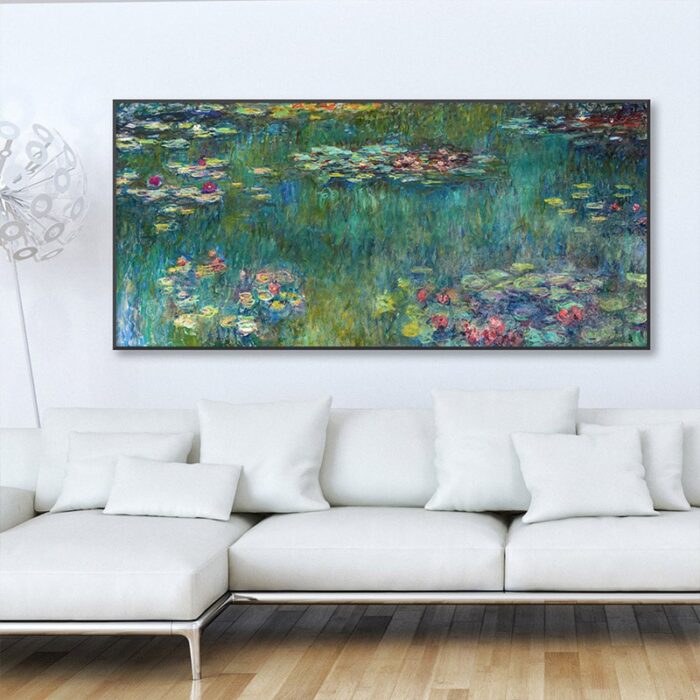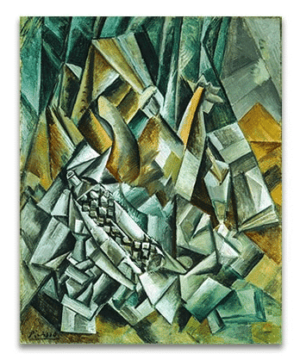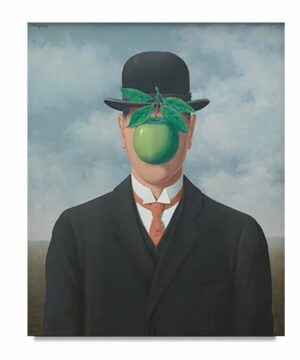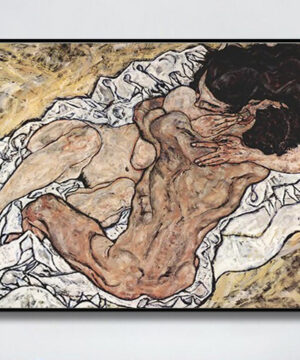In the final decades of his life, Claude Monet dedicated his work almost entirely to paintingPainting is a fundamental form of visual art that has been practiced for thousands of years. It involves applying pigment to a surface such as canvas, paper, or a wall. Painting can be explored through various styles, techniques, and mediums, each offering unique possibilities for expression and creativity. Historical Background • Ancient Beginnings: The history of painting dates back to More water lilies. He embarked on series of monumental murals depicting lavish lily ponds, which he called “grandes decorations”, enveloping the viewer in the vastness of the flora of his gardens and the bucolic landscape, the water and the sky. This enormous plan materialized in the form of over 40 large-scale panels, among them “Water Lilies – Green Reflections”, which Monet created working continuously from 1914 until his death in 1926.
Where is the picture “Water Lilies – Green Reflections“ today?
Claude MonetFrench painter Claude Monet (1840 – 1926) was a key figure of the impressionist movement which started in the second half of the 19th century. During his long career, Monet focused on depicting leisure activities and plein air landscape painting. Born in Paris, his family moved to Le Havre in Normandy when Claude was 5 years old. From early on, More bequeathed his Water Lily paintings to the French state. Since 1927 they have been displayed in custom-built oval exhibition halls specifically designed for his murals at the Musée de l’Orangerie in Paris. 30 vast canvasses are fixed together to fill the walls, giving the viewers the sensation to be surrounded by shimmering ponds and bucolic landscapes. “Water Lilies – Green Reflections” is one section of the murals and is still part of the permanent collection of the Musée de l’Orangerie today.
What’s in it?
The large-scale paintingPainting is a fundamental form of visual art that has been practiced for thousands of years. It involves applying pigment to a surface such as canvas, paper, or a wall. Painting can be explored through various styles, techniques, and mediums, each offering unique possibilities for expression and creativity. Historical Background • Ancient Beginnings: The history of painting dates back to More “Water Lilies – Green Reflections” depicts a scene from a water lily pond at the garden of Monet in Giverny in north-western France. Lilies bloom in an abundant pool of green and blue, dappled with yellow, white, and pink exotic variants and frothed with lavender-tinged reflections of clouds. Heavy brushstrokes in darker shadesIn color theory, a shade is a darker version of a color, created by adding black to the original hue. This concept is essential for artists and designers, as it allows for a range of deeper, more intense tones that can add depth and drama to a composition. Defining Shade A shade results from mixing a pure hue with black. More ooze in between the flowers and mingle with the reddish-green vegetation. The composition hovers in between abstraction and realistic representation, also due to the lack of horizon, leading to the effect of complete immersion.
What’s the context of Claude Monet’s Water Lilies?
Following the path of the late French landscape painters of the romantic movement earlier in the 19th century, Claude MonetFrench painter Claude Monet (1840 – 1926) was a key figure of the impressionist movement which started in the second half of the 19th century. During his long career, Monet focused on depicting leisure activities and plein air landscape painting. Born in Paris, his family moved to Le Havre in Normandy when Claude was 5 years old. From early on, More extended their methods committing himself to close observation and naturalistic representation. Water lilies dominated the last 30 years of his life. In 1909, he wrote in a letter to a friend: “It is beyond my strength as an old man, and yet I want to render what I feel.” The focus of his obsession became a garden at his home in Giverny, a commune northeast of Paris. He precisely designed the planting of his gardens and undertook a vast landscaping project including the lily ponds. Local French white water lilies were planted along with imported variants from Egypt and South America for a wide variety of colours. His garden became a gathering place for friends, among them the two artists Auguste Renoir and Édouard Manet, who joined their host in paintingPainting is a fundamental form of visual art that has been practiced for thousands of years. It involves applying pigment to a surface such as canvas, paper, or a wall. Painting can be explored through various styles, techniques, and mediums, each offering unique possibilities for expression and creativity. Historical Background • Ancient Beginnings: The history of painting dates back to More en plein airThe French term “en plein air” means “out-doors”. Plein air painting therefore refers to the practice of painting an entire finished picture out of doors. Artists have long worked out of doors to create landscape sketches for the preparation of further studio work. The plein air approach, finishing entire pictures out-doors, however, began only in the 19th century, initiated by More.
Chatter and Prattle
Claude MonetFrench painter Claude Monet (1840 – 1926) was a key figure of the impressionist movement which started in the second half of the 19th century. During his long career, Monet focused on depicting leisure activities and plein air landscape painting. Born in Paris, his family moved to Le Havre in Normandy when Claude was 5 years old. From early on, More – Facts:
- Many of Monet’s water lily pictures were painted while suffered from cataracts, which might have had an influence on how he saw the colours of his surroundings. The artwork he created while cataracts affected his vision had a more reddish tone, which is characteristic of the vision of people suffering from cataract. In 1923, after he underwent eye operations, he was most likely able to see certain ultraviolet wavelengths of light which are excluded by the lens of unimpaired eyes. After his recovery from the surgery, he decided to repaint some of his water lily pictures with deeper tonesIn color theory, a tone is a version of a color created by adding gray (a mix of black and white) to the original hue. This concept is essential for artists and designers as it allows for a wide range of colors that are neither too dark nor too light, providing versatility in creating depth, mood, and harmony within a More of blue than before.
- In the latter decades of his life, Monet almost exclusively painted en plein airThe French term “en plein air” means “out-doors”. Plein air painting therefore refers to the practice of painting an entire finished picture out of doors. Artists have long worked out of doors to create landscape sketches for the preparation of further studio work. The plein air approach, finishing entire pictures out-doors, however, began only in the 19th century, initiated by More in his garden. When a journalist once asked to visit him in his studio, he replied: “My studio! I have never had a studio, and I simply cannot understand how one can lock oneself into a room. Maybe to draw; but to paint … never! Look, that is my studio…” pointing at the landscapes of his garden.
- In December 1926 Monet died of lung cancer at the age of 86. He was buried in the Giverny church cemetery. Monet’s good friend Georges Clemenceau, a French statesman who had served as Prime Minister twice, attended the funeral. He removed the black cover draped over the coffin and replaced it with a flower-patterned cloth saying: “No black for Monet!”
Do you want to comment on this text or add information? We would like to hear from you.
Recommended Readings:
This article may contain compensated links. Please read Disclaimer for more info. As an Amazon Associate, I earn from qualifying purchases.
Daniel Wildenstein (2010): Monet or The Triumph of Impressionism
Ross King (2016):Mad Enchantment: Claude Monet and the Painting of the Water Lilies
Christoph Heinrich (2015): Monet (BASIC ART) (French Edition)
Simona Bartolena (2011): Monet: Masters of Art
Dominique Lobstein (2013): Claude Monet’s Gardens at Giverny













Reviews
There are no reviews yet.